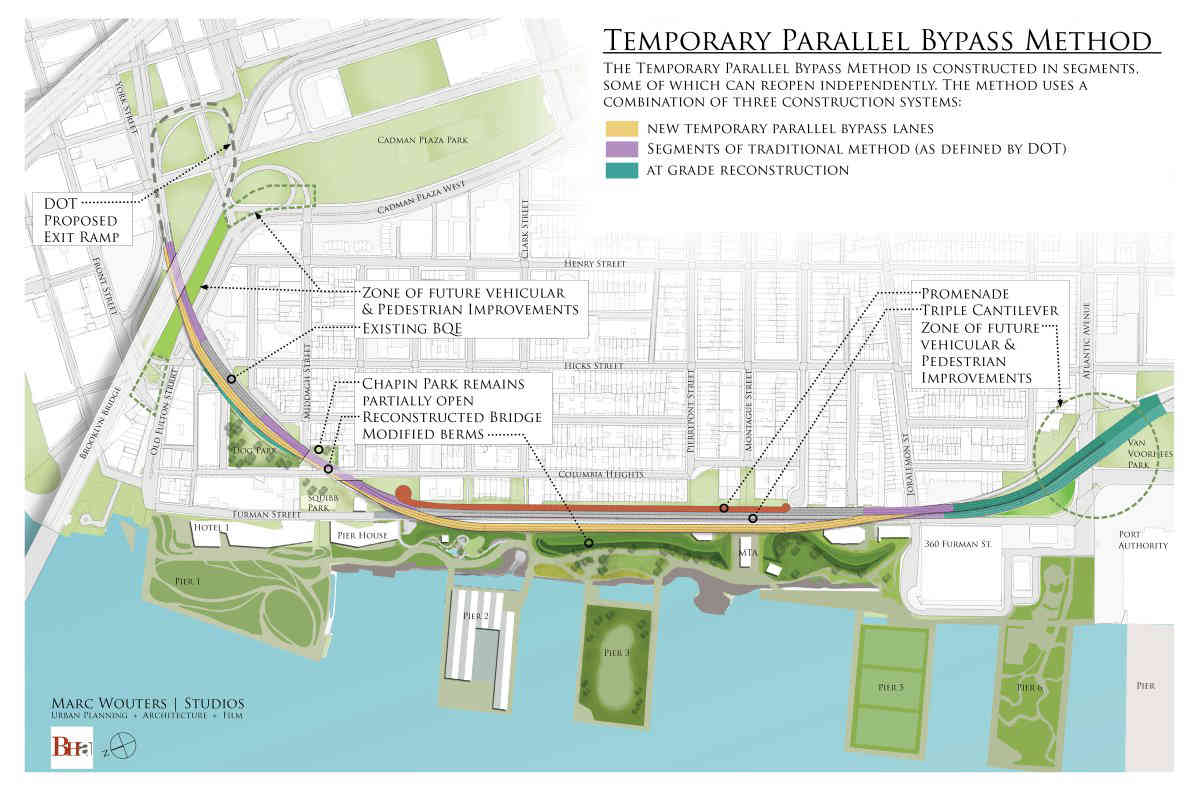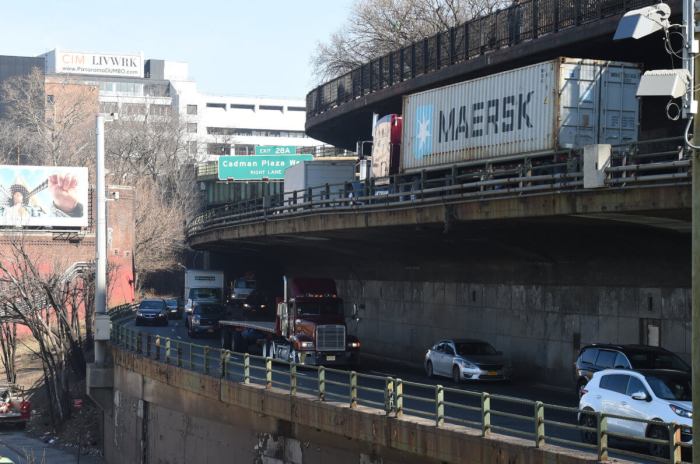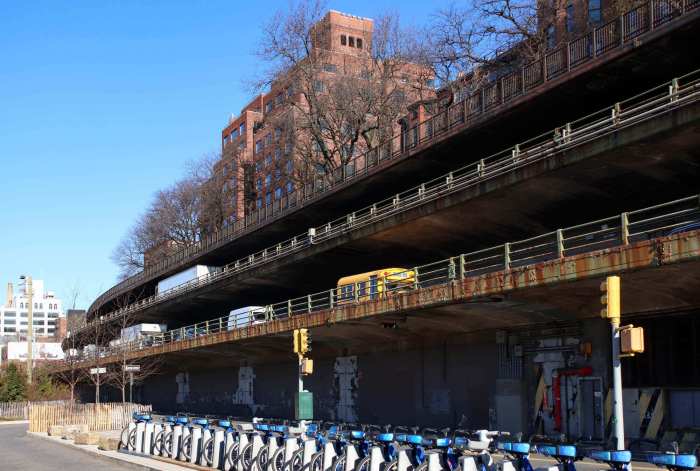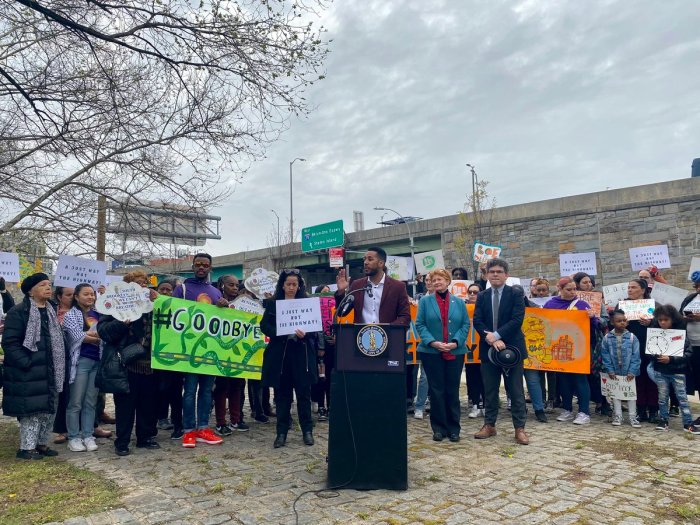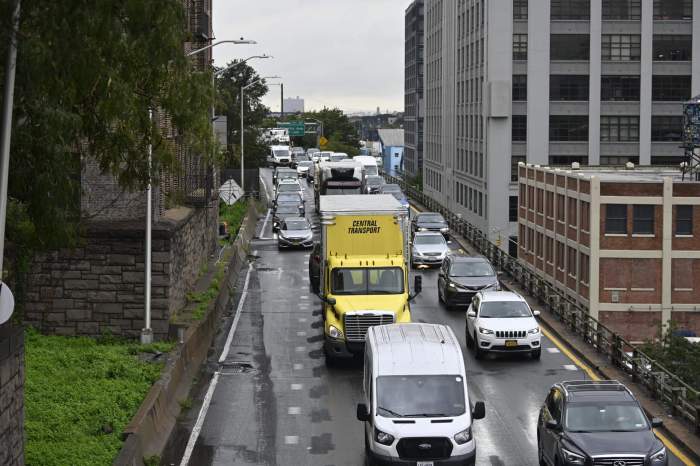The architect who late last year proposed a third way to fix the Brooklyn–Queens Expressway’s triple cantilever unveiled more details for the scheme that proposes sending traffic down a temporary roadway near Brooklyn Bridge Park.
Diverting cars and trucks along an interim road built closer to the meadow will allow the critical job to wrap faster than either of the city’s two options, and spare the Brooklyn Heights Promenade from becoming a speedway in some residents’ backyards, the urban planner said.
“We’re really thinking this is going to be a much shorter duration. When we take all traffic and put it to the side on a temporary highway, it means that it should be easier to rebuild the old triple cantilever,” Marc Wouters, who lives in Brooklyn Heights, told this newspaper.
Wouters’ proposal, which the city is now analyzing, calls for erecting a two-tiered roadway that features three lanes for Bay Ridge–bound vehicles on one level, and another three lanes for Queens-bound traffic on the other.
The temporary structure would rise right behind Brooklyn Bridge Park’s man-made hilly berms along part of Furman Street, some of which might need to be hacked down to accommodate it. But building the interim highway there would leave all of the waterfront park’s pathways and play spaces untouched, and only minimally affect some of the meadow’s parking lots and service buildings, according to Wouters, who created the plan at the request of leaders of local civic group the Brooklyn Heights Association.
“We love the park, everybody we talk to wants to make certain the park remains completely active and open,” he said. “It seems like a place where you could put a temporary highway and not really do any harm to the park.”
Meadow stewards with the semi-private Brooklyn Bridge Park Corporation, however, said they have questions and concerns about how Wouters’s design may affect the green space, and plan to share those with officials as the city continues to weigh it.
The architect’s plan calls for repairing the 1.5-mile stretch of expressway between Atlantic Avenue and Sands Street, which includes the triple cantilever, in segments. He has already designed a temporary roadway between Atlantic Avenue and the Brooklyn Bridge, which would accommodate traffic while workers repair the stretch of highway between those points, and said that roadway would be extended as construction moves along the highway.
The segmented repairs would allow some swathes of the expressway to reopen to traffic even as others are being fixed, pushing the job forward while limiting the need to reroute vehicles, Wouters said.
“Our plan can actually be built in segments, you can build a segment, finish 100 percent and be done, and then build another segment,” he said.
Wouters does not yet have a full cost estimate or timeline for his fix, but said it could take at least six years — roughly the same amount of time as the quicker of the city’s two plans — and come in cheaper than either of the Department of Transportation’s two proposals, which at nearly $4 billion, are now more than twice the price initially estimated for the job.
“We know that some components are less expensive,” he said.
The architect’s scheme would still require temporarily closing the parts of the Promenade that sit atop the 70-year-old triple cantilever in order to shore it up, work that the city accounted for in its so-called “traditional approach” to repairing the road, which calls for fixing the three-tiered highway lane by lane over no fewer than eight years.
But it would avoid shuttering the Promenade entirely and turning it into a six-lane highway for at least six years as proposed under the city’s so-called “innovative approach” endorsed by Mayor DeBlasio — and likely save lives in the process, by sparing locals from breathing in toxic chemicals emitted by vehicles on that highway constructed just feet from some area homes.
A Transportation Department rep previously told this newspaper that the Promenade-turned-highway would run from Congress to Adams streets, and renderings released yesterday by opponents of the innovative plan show the elevated roadway would block views of the Manhattan skyline as it crosses over the foot of the Brooklyn Bridge near Adams Street.
City transit leaders said they hope to kick off repairs to the expressway as soon as 2020 — roughly six years before experts warn the triple cantilever could start to collapse under the weight of the thousands of trucks that rumble along it daily. And officials promised locals will get the chance to weigh in on all fixes on the table, including Wouters’s and others, as they work to put a plan in place over the next two years, according to an agency rep.
“We are analyzing the association’s plan, as well as a range of other concepts and are continuing to work with elected officials, the community, and all local stakeholders on the entire project corridor to hear their input,” she said. “We expect to identify a number of additional options, which will be weighed in public discussions as part of a thorough review process that will last about two years.”
